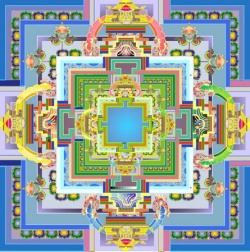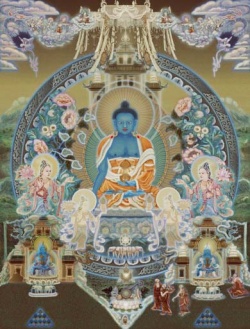Sādhanas and Deity Yoga
As stated earlier, a sādhana is literally a "means of achievement." What is achieved may be mundane, such as the eight great feats (flying or recovery of youth, etc.) (Tsong kha pa: 59) or the four activities of pacification (of demons, etc.), increase (of lifespan, etc.), subjugation, and ferocity (Dalai Lama XIV, 1984: 98). The aim of most sādhanas, however, is the greatest of all achievements, the attainment of buddhahood. The principal means to this end is the work of deity yoga, which mainly involves the construction of maṇḍalas (dkyil 'khor), literally "circles." The maṇḍalas are of two types, a residence (a divine mansion) and residents (deities) that together represent the entire cosmos and its occupants.14 To visualize these complex images requires great concentration and, at least initially, great effort, for one must build up the image, re-vivify those aspects of it that become hazy or dull, and envision its transformation during the course of the sādhana. In addition, one may simultaneously be imagining oneself to be the deity that is visualized.
Nevertheless, one is called upon to realize (or at least imagine) that this image is not merely one's fabrication, for the marvelous maṇḍalas that appear in space are really nothing less than the progressive manifestation of one's own mind that realizes emptiness, appearing in form. That is, one is to regard oneself as a buddha;15 on this basis, one imagines that one's omniscient consciousness that never wavers from absorption on emptiness (one's Truth Body (dharmakāya, chos sku)) manifests visibly as the divine residence and residents (one's Form Body (rūpakāya, gzugs sku)).16 Moreover, one imagines that this manifestation in form occurs without deliberation, being the spontaneous display of compassion.17 In short, one is to live proleptically in one's future buddhahood by pretending that one's own wisdom appears as the maṇḍala.
The particular sādhana one practices, and hence, the deity one achieves, is related to the guidance one receives in the choice of a type of Tantra—from the classes of Action (bya), Performance (spyod), Yoga (rnal byor) or Highest Yoga (rnal 'byor bla med)18—and in the choice of the deity that is its focus,19 which may very well be affected by the religious order to which one belongs, as noted earlier. One's choice also is, in principle, linked to one's psychic makeup. A striking feature of tantric icons is that they may be either[page 335] peaceful or wrathful in aspect; identification with one or the other through creative visualization affords one the opportunity to use productively even one's negative emotions, such as lust or hatred, in the service of the spiritual path. For instance, as a deity yogī, one may take on the fierce aspect of a deity such as Kālacakra. However, that fierceness will be directed not against others, but rather, it will ravage one's own inner adversaries of ignorance, desire, and hatred. Or, one may experience the bliss of Kālacakra's sexual union with Viśvamātā, but that bliss will be used to energize the wisdom that realizes emptiness.
Significantly, aggressive action need not indicate harmful intent; as the fourteenth Dalai Lama notes (1984: 98), the tantric practitioner's motivation should always be that of compassion for others. It may seem paradoxical to embody anger or lust when these are what one is committed to oppose; however, this "embodiment" is analogous to the way in which, in the context of meditating on emptiness, one deliberately appropriates the "I" of a deity by thinking of oneself as that deity (known as having "divine pride"). Despite this apparent regression into dualistic awareness, seemingly the very opposite of what one ought to be doing, the substitution of the deity's "I" for one's own undermines one's ordinary false sense of "I" and thus facilitates one's discernment of selflessness (Dalai Lama XIV, 1977: 64). So too, here the experience of aggression or bliss, which occurs within thinking of oneself as a deity, undermines one's ordinary anger and lust, which arise through trying to protect and enhance one's ordinary ego.
Notes
[14] Gómez (378) notes concisely that the maṇḍala is at once a chart of the present human being, a plan for liberation, and the representation of a transfigured body; that is, the parts of the maṇḍala can be homologized to the personal aggregates, it is the context for liberation, and it may be homologized to the body of the buddha one is to become.
[15] Although all supramundane deities in the tantric maṇḍalas are forms of buddhas, some take the form of bodhisattvas of high attainment such as sPyan ras gzigs (Avalokiteśvara) or sGrol ma (Tārā); see Dalai Lama XIV, 1984: 96.
[16] In most tantras, the particular Form Body would be an Enjoyment Body (longs sku, sambhogakāya), but since this is not the case for the Kālacakra Tantra, the less specific term is used.
[17] Buddhas are said to have transcended the need for conceptual awareness; all of their actions occur spontaneously, without deliberation, in reaction to the needs of sentient beings.[page 341]
[18] The rNying ma religious order recognizes six sets, a result of dividing the latter category into three sets.
[19] Each set of tantras has many deities associated with it. Some deities, such as Tārā, have both lower tantra and Highest Yoga Tantra sādhanas. There are differences in the structure of such sādhanas, as will be discussed below, but there is also the difference that practitioners of Action and Performance Tantras are not required to take special tantric vows. Also, it should be noted that a sādhana does not necessarily have only one main deity. The guru yoga instructions of the Dalai Lama (1988: 11) combine visualizations of Yamāntaka, Guhyasamāja, and Heruka in the guru's body.

